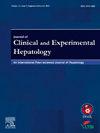人工智能在肝脏病理学中的应用:精确的组织学诊断
IF 3.2
Q2 GASTROENTEROLOGY & HEPATOLOGY
Journal of Clinical and Experimental Hepatology
Pub Date : 2025-08-08
DOI:10.1016/j.jceh.2025.103145
引用次数: 0
摘要
人工智能(AI)是一种模拟或模仿人类“智能”的技术或工具。精确医学或精确组织学是指针对亚人群的疾病诊断、治疗和管理,具有社会文化、行为、基因组、转录组学和药物组学意义。近十年来,基于人工智能的模型在日常生活的各个方面都有了巨大的飞跃,包括精准医学和组织学的实践。这些基于人工智能的模型有助于整理临床数据,减少决策过程中的时间和费用,提供顺畅的工作流程,并基于算法方法预测结果。随着全切片成像和数字病理学的出现,组织病理学家可以有效地实施基于图像的算法,通过机器学习和深度学习(人工智能的分支)生成客观的组织数据。因此,人工智能驱动的模型可以在肝脏组织学中实施,以减轻重复和繁琐的任务负担,预测各种结果,减少病理学家之间观察者之间和观察者内部的差异,并收集各种超组织学预测数据。本文简要介绍了人工智能在肝脏病理学中的应用,并讨论了人工智能的基本原理、人工智能在精确肝脏组织学中的应用以及人工智能面临的挑战。本文章由计算机程序翻译,如有差异,请以英文原文为准。
Artificial Intelligence in Liver Pathology: Precision Histology for Accurate Diagnoses
Artificial intelligence (AI) is a technique or tool to simulate or emulate human “intelligence.” Precision medicine or precision histology refers to the subpopulation-tailored diagnosis, therapeutics, and management of diseases with its sociocultural, behavioral, genomic, transcriptomic, and pharmaco-omic implications. The modern decade experiences a quantum leap in AI-based models in various aspects of daily routines including practice of precision medicine and histology. These AI-based models aid in the curation of clinical data, reduce the time and expense in decision-making, provide a smooth workflow, and predict the outcomes based on an algorithmic approach. Histopathologists can effectively implement image-based algorithms with the advent of whole-slide imaging and digital pathology generating objective histological data through machine learning and deep learning, branches of AI. Thus, AI-powered models can be implemented in liver histology to reduce the burden of repetitive and tedious tasks, predict various outcomes, reduce inter-observer and intra-observer variability between pathologists, and glean diverse supra-histological predictive data. This review article provides a brief overview of AI in liver pathology and deals with the basic principles of AI, its utility in precision liver histology, and its challenges.
求助全文
通过发布文献求助,成功后即可免费获取论文全文。
去求助
来源期刊

Journal of Clinical and Experimental Hepatology
GASTROENTEROLOGY & HEPATOLOGY-
CiteScore
4.90
自引率
16.70%
发文量
537
审稿时长
64 days
 求助内容:
求助内容: 应助结果提醒方式:
应助结果提醒方式:


